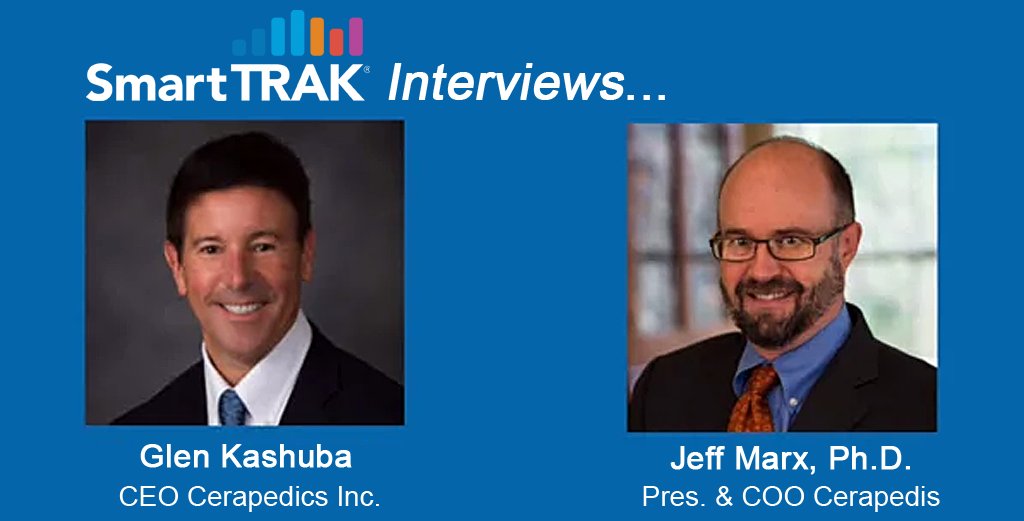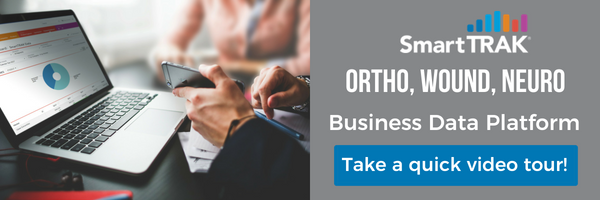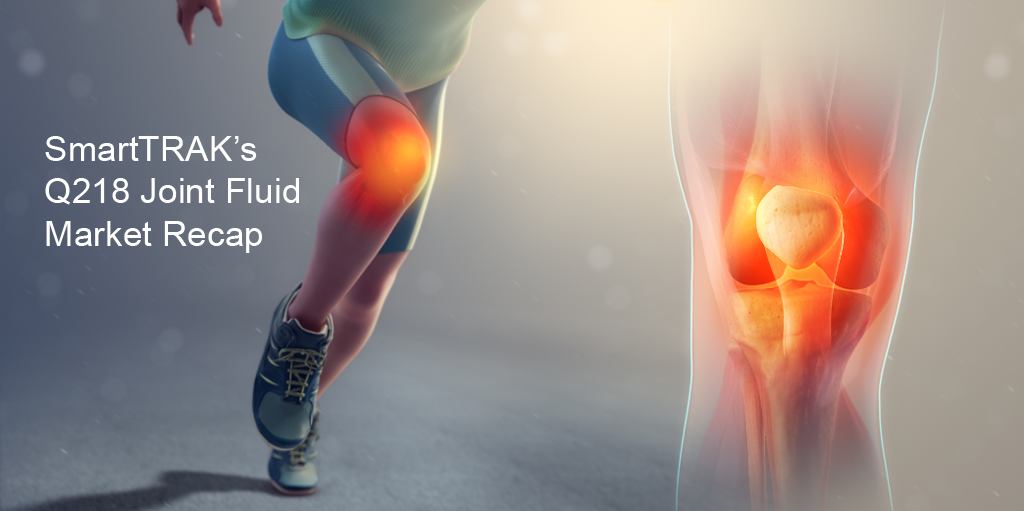 Cerapedics’ CEO Glen Kashuba and President and COO Jeff Marx, Ph.D. discuss the future of the bone graft substitutes and the uniqueness of i‑FACTOR Peptide Enhanced Bone Graft, a small peptide technology in an interview with Kim French, Sr. Analyst, SmartTRAK Orthbio.
Cerapedics’ CEO Glen Kashuba and President and COO Jeff Marx, Ph.D. discuss the future of the bone graft substitutes and the uniqueness of i‑FACTOR Peptide Enhanced Bone Graft, a small peptide technology in an interview with Kim French, Sr. Analyst, SmartTRAK Orthbio.
A transcript of SmartTRAK's interview with Glen Kashuba and Jeff Marx is below, or click on the following video to listen to the interview.
This is Kim French with Biomed GPS and we are fortunate to meet with Cerapedics leadership to discuss the company and their peptide enhanced bone graft technology i-FACTOR. With us today is Glen Kashuba, Chief Executive Officer, and Jeff Marx, Ph.D. President and Chief Operating Officer. Gentlemen, thank you for your time.
Jeff Marx: Thank you.
Glen Kashuba: Thank you.
First, congratulations on your recent MedTech Breakthrough Award and FDA approval to initiate an IDE Clinical Trial to evaluate i-FACTOR in TLIF surgery. From my understanding, the core technology of i-FACTOR, P-15, has been a proven bone substitute in dentistry since 2000, and has been available for ACDF since 2015. Please tell me a little more about how the core technology has been enhanced and how this has inspired the launch of Cerapedics?
JM: I can take that one. So, like most bone grafting technologies, there has been an evolution over time, both in terms of the understanding of how the material works, as well as slow improvements to technology for delivery, as well. So, we have learned an awful lot about the "Attract. Attach, Activate" mechanism of action of the P15 molecule in i-FACTOR, and have been applying that successfully in our commercial efforts, both outside of the United States since 2008, as well as in the United States since late 2015. Along those lines we have also developed the next generation version of the product, and that is what we used in the TLIF trial that is about to get underway.
GK: As an added comment, regarding the transition from the initial base technology, the company received approval for i-FACTOR in OUS markets in 2008 via CE MARK and TGA approval so i-FACTOR has been available commercially for Spinal fusions as well as other general orthopedic indications. At this point, we have well over 40,000 cases under our belt. So, the technology was very much proven to be safe and effective as the company initiated the Investigational Device Exemption for ACDF. As mentioned, we have successfully completed that IDE trial resulting in a PMA approval at the end of 2015 becoming only the second Class 3, PMA approved drug-device orthobiologic in the market. This is a major accomplishment as the only other orthobiologic approved in spine as a class 3 drug-device orthobiologics was BMP which had achieved sales over $900M before declining to roughly $500M due to its high expense and safety concerns. So, i-FACTOR has been used and had excellent clinical success in the OUS market as early as 2008.
“We have successfully completed that IDE trial resulting in a PMA approval at the end of 2015 becoming only the second Class 3, PMA approved drug-device orthobiologic in the market. At this point, we have well over 40,000 cases under our belt. So, the technology is very much proven to be safe and effective.” – Glen Kashuba
As you know, the US market is very crowded and there are currently over 400 bone graft substitutes in the market. How is i-FACTOR different and what are the benefits to patients and surgeons?
JM: i-FACTOR is different in a couple of important ways. First and foremost, it is a drug device combination product, so is very active in terms of driving the biological response within the patient post-implantation. The P-15 molecule is a 15 amino acid peptide. It's a synthetic replicate of a native peptide that is a part of type 1 collagen. That part of collagen is what's responsible for cellular attachment through all mammalian connective tissues. When this peptide is placed onto the surface of our inorganic bone mineral and implanted, it will actively attract, attach, and activate bone forming cells. So as a drug device combination product, the pathway to approval through the FDA was via and IDE and a PMA. So, we have very high quality, prospective level 1 data from our IDE trial in which to support the clinical efficacy and the value of the product in the marketplace. And in our IDE trial, where i-FACTOR was compared directly to autograft, we are actually able to demonstrate statistical superiority in overall clinical outcome as compared to autograft.
You compare and contrast that to most of the competitive products in the marketplace that have gotten there via either a 510K, or perhaps by the HCT/P process, there is little to no clinical evidence to support their value and their use other than just simply as a bulking agent, as a passive bulking agent for autografts.
“When this peptide is placed onto the surface of our inorganic bone mineral and implanted, it will actively attract, attach, and activate bone forming cells.” – Jeff Marx, Ph.D.
GK: Yes, there are a number of points of differentiation, Kim, not only the safe and proven mechanism of action of i-FACTOR and its Class 3 regulatory classification, but also, we know that i-FACTOR performs quite well from a safety and efficacy standpoint as supported by the OUS experience, the U.S PMA and the results we see from our U.S. clinicians and new U.S. surgeon users. For me, the major differentiator, which is a very important point, is the fact that we do have the level 1 human clinical data, and that's important not only for hospital approvals, but also for reimbursement. The importance of level 1 human clinical data will continue to be more and more important, hence our decision to invest in another level 1 human clinical trial for TLIF lumbar spine. This clearly sets us apart from all other products.
It sounds very differentiated. Since its launch, can you share some of your company's successes and milestones?
GK: Sure, let me lead off and then we could back-fill some more of the details. After getting approval at the end of December of 2015, our focus was to improve our labeling with the FDA, by incorporating the responder analysis which demonstrated i-FACTOR’s superiority to autograft. We were also successful in adding additional sizes to our portfolio. So essentially, our initial launch was mid-2016, and at that point the goal was to establish a very focused commercial team supported by a customer-friendly infrastructure, which we were able to complete the latter half of '16, as we started early commercialization. As you know, the challenge in many medical device markets is getting hospital approvals, and with a very experienced and capable team in place, we started that process at the end of '16. Much time and energy were invested, and a large number of hospital approvals were completed in '17. And then once you start to lay out that successful process, the opportunity had been created to attract strong top-tier, experienced distributors that we subsequently engaged and trained, and then partnered with these distributors to accelerate the hospital approval process. Clearly, these hospital approvals would not have been possible without the support of surgeon champions who believed in the product as a result of the Level 1 human clinical data and / or their own clinical experience. For me, executing an efficient hospital approval process really has been the major milestone we've accomplished this past year; I think we have executed this quite well and have a substantial pipeline of new hospital approvals planned for the rest of 2018 and into 2019.
JM: I would add on top of that having filed and very quickly gotten approval from FDA to initiate a second IDE trial in the TLIF application.
Thank you. Speaking of the clinical trial, can you tell me a little more about that IDE trial?
JM: We're really excited about this study. I think it's going to be sort of a landmark in the treatment of spine. The very straightforward study design is single level TLIF. The patients are going to either receive our P-15L bone graft, which is the next generation version of i-FACTOR, inside and around a peak interbody device, or local autograft as the control. The study is utilizing a composite outcome with four primary components, one of which is radiographic fusion. And the endpoint for FDA filing is two years, but all the patients are going to be followed for six years. We're excited about the trial in that it's going to allow us to show efficacy in the largest segment of the market for bone grafting, and we believe, based on our OUS and US clinical experience to date, that our likelihood of success here is exceptionally high.
This somewhat answers my next question about the opportunities in the United States. As you know, US spine fusion procedures are estimated to exceed about 670,000 in 2018. Especially if you are approved for your TLIF, which we know is going to be a few years down the road, what do you feel is the market opportunity for you?
GK: We've always looked at the market as a $2.85 billion worldwide opportunity. The US market, specifically spine, is a $2 billion opportunity. Just to be clear, this is specifically the orthobiologic segment of the market, not any hardware, or any fusion devices. We then sub-segment that into a $500 million cervical market, meaning orthobiologic products being used in the cervical spine with the balance being the $1.5 billion in the lumbar. So, we think this is a very significant opportunity. We also segment the market in term of competitive products. We have been focused on the 2 largest product segments of the market, BMP and Stem cells. BMP’s are very expensive and have had issues related to ectopic bone growth and safety. Stems cells which are also expensive, are regulated as minimally manipulated tissue requiring no human clinical data so, as you would expect, there is no human clinical data to support safety and efficacy. We see the BMP market at approximately $500M and the collective stem cell segment at $400M. So that’s a $900M million market opportunity that we’re targeting. We feel i-FACTOR is very well positioned in this high-end market segment and we have been very successful in taking market share as i-FACTOR provides safety and efficacy, backed by Level 1 Human clinical data AND is also cost-effectiveness which is very important to both hospitals and payors.
“The US market, specifically spine, is a $2 billion opportunity and we are targeting the $900 million high-end market segment. We have been very successful in taking market share as i-FACTOR provides safety and efficacy, backed by level 1 Human clinical data AND is also cost-effectiveness which is very important to both hospitals and payors.” – Glen Kashuba
Right, thank you. As you know, with some of those newer technologies, stem cells, et cetera, some of these companies have faced reimbursement and other market challenges. Have you experienced or expect to experience any commercialization issues?
JM: We really have not had many challenges with regard to reimbursement to this point. I think that is likely to continue to be the case. If you look at cervical fusion reimbursements in the US, at least in the private pay market, that is generally under a DRG basis. The payer pays the hospital a bundled payment for the entire procedure, and then the hospital's costs, basically, come out of their profit relative to that. All of the major payers in the US have published reimbursement guidelines and in fact state which bone graft materials they believe are experimental, and therefore, are not reimbursed. It's interesting because virtually all other commercial technologies are listed as experimental and could potentially be denied reimbursement by most of the major payers. We don't believe we're going to end up in that bucket with those challenges for the primary reason that we have data from our IDE clinical trial.
So once again, we demonstrated in a large prospective randomized study that i-FACTOR is superior to autograft and overall clinical outcome in single level ACDF. So, we have not seen reimbursement challenges to date. That could always change in the future, but we believe we're in a very strong position to address any challenges or concerns there, particularly, as compared to our competitors.
GK: To add to that - what drives our confidence with respect to reimbursement - is the level 1 human clinical data that we can discuss and demonstrate, if there is any type of pushback from either the hospital or private payer. i-FACTOR is very well positioned in the market relative to reimbursement as most of the competitive products in the market have no real response to hospitals or payors considering the lack of human clinical data. We've recently seen a very interesting trend in where many of the stem cell products are being really removed or banned from hospitals based on the reimbursement challenges hospitals are facing.
Specifically, as part of this trend we’ve started to see line itemization for the approval of various technologies, for example, if an expensive bone graft is being used, i.e., a stem cell, that is not backed by human clinical data, and no proof of efficacy, then hospitals are not allowing that product to be used anymore, simply because they're getting pushback from the payer. So that's an emerging trend that we started to see maybe back in mid-'16, and it's carried through to this year. And there are multiple well-known hospitals and institutions that we know that stem cells are actually being banned because of that reimbursement challenge. We don't see that issue for i-FACTOR simply because our product is backed by level 1 Human clinical data and surgeons are willing to fight for hospital approval armed with this data. In addition, we have actively engaged the top spine surgeon societies as well as a number of private payors who have approached us based on the significance and quality of our clinical data
Let's talk about the future of the company. Looking ahead, how do you think orthobiologics and regenerative technologies will evolve? And how will this influence your pipeline?
JM: Yeah, that's a really good question. I think there are a couple of trends that are underway today, and you can extrapolate some of those trends going forward, but it's largely a guess as to which of those will be sustained or not. So, I think one of those trends that I do anticipate being sustainable and growing, is the continued reliance of both payers and hospital value analysis committees on clinical evidence to support the use of a product. That has been going for quite some time, certainly gathering additional strength, and with the changes in healthcare going forward, that trend is going to continue to strengthen.
I think that sort of plays into some of the other trends, one of which is increasing pressure on the stem cell, or cellular allograft tissue material. So, these materials have been in the market for quite some time, being marketed as HCT/P, minimally manipulated homologous tissue. There is very little to no clinical evidence to support their use, still at this point and they're at a very high price point. So, that category of products is coming under pressure for the lack of data, for the high price points, et cetera. I think if you look at the synthetic bone graft and DBM segments of the market, those have largely been stable as far as their percentage of the market for quite some time. The gross numbers don't seem to be changing particularly much. It's just sort of jockeying for position by the players within that market. So, BMP had dropped off precipitously because of some of the safety concerns, but has been growing again in recent years, I think, as surgeons have gotten better about choosing which patients to use it on, and what applications. I would expect that that trend will continue going forward.
But fundamentally, I don't see a ton of new technology in development that are going to fundamentally change the market outside of our continued introduction and focus on sharing the word about i-FACTOR. But the continued reliance on data, and having to demonstrate value, they are going to continue for sure.
GK: Just to add to that, while not a specific product feature, I believe there will be an increasing need to demonstrate safety and efficacy of a product by conducting level 1 Human clinical trials. This is an expensive process, it's a timely process, but we think that it is such an important aspect of proving the safety and efficacy and value of a product in humans, and is well worth the return, once the additional trials are completed. This is especially true for hospitals and payers. Hence our excitement and commitment to executing our second IDE study for Spine in Lumbar
JM: I had a mentor in my career early on who used the phrase that I think is incredibly apt here. And he would say that the product is the data, and the data is the product. So, in the market currently, and particularly going forward, if you're standing on the sidelines with no human clinical data to support your product, you're going to really be challenged to continue to be successful in marketing in this market.
“The product is the data, and the data is the product. Going forward, if you're standing on the sidelines with no human clinical data to support your product, you're going to really be challenged.”– Jeff Marx, Ph.D.
I couldn't agree with you more. Cerapedics is a private company, are there any plans to go public?
GK: We just raised additional capital which will allow us to support our two major initiatives of commercialization ramp and our second IDE level I study for lumbar spine. We will continue to focus on what we can control so the plan is put our heads down, continue to execute and create value for our shareholders. As time goes on, we will evaluate various opportunities, but nothing specific at this point in time. We feel very comfortable about our team, how we have executed thus far and how well i-FACTOR has been received in the market thus far. We want to continue to build value over time, execute as we have been over the last few years, and I’m sure good things will come our way especially if we continue to focus on i-FACTOR and support it with human clinical data.
Well Glen and Jeff, I can't thank you enough for discussing Cerapedics and the i-FACTOR product. I wish you the best.
JM: Thank you very much.
GK: Thank you, Kim, appreciate it.






